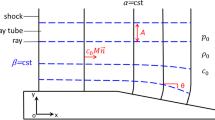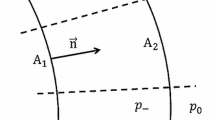Abstract
We consider a system that belongs to the class of well-known Painlevé problems; to solve it, we use the method of opening spatio-temporal singularities proposed by the authors. This method makes it possible to unambiguously solve the problem of finding the speeds of a body after hitting a surface with dry friction, i.e., to resolve a situation where traditional approaches either yield an ambiguous answer or lead to an infeasible system of relations (the Painlevé paradox).
Similar content being viewed by others
References
Tsypkin, Ya.Z., Perekhodnye i ustanovivshiesya protsessy v impul'snykh sistemakh (Transition and Steady-State Processes in Impulse Systems), Moscow: Gosenergoizdat, 1951.
Tsypkin, Ya.Z., Teoriya impul'snykh sistem (Theory of Impulse Systems), Moscow: Fizmatgiz, 1958.
Tsypkin, Ya.Z., Teoriya lineinykh impul'snykh sistem (Theory of Linear Impulse Systems), Moscow: Fizmatgiz, 1963.
Polyak, B.T., Development of Automatic Control Theory, Probl. Upravlen., 2009, no. 3.1, pp. 13–18.
Halanay, A. and Wexler, D., Teoria Calitativă a Sistemelor cu Impulsuri, Bucureşti: Editura Academiei Republicii Socialiste România, 1968. Translated under the title Kachestvennaya teoriya impul'snykh sistem, Moscow: Mir, 1971.
Tsypkin, Ya.Z. and Popkov, Yu.S., Teoriya nelineinykh impul'snykh sistem (Theory of Nonlinear Impulse Systems), Moscow: Nauka, 1973.
Rishel, R.W., An Extended Pontriagin Principle for Control Systems whose Control Laws Contain Measures, J. SIAM, Ser. A, Control, 1965, vol. 3, no. 2, pp. 191–205.
Miller, B.M. and Rubinovich, E.Ya., Impulsive Control in Continuous and Discrete-Continuous Systems, New York: Kluwer, 2003.
Miller, B.M. and Rubinovich, E.Ya., Optimizatsiya dinamicheskikh sistem s impul'snymi upravleniyami (Optimization of Dynamical Systems with Impulse Controls), Moscow: Nauka, 2005.
Miller, B.M. and Rubinovich, E.Ya., Optimizatsiya dinamicheskikh sistem s impul'snymi upravleniyami i udarnymi vozdeistviyami (Optimization of Dynamical Systems with Impulse Controls and Impact Interactions), Moscow: LENAND/URSS, 2019.
Miller, B.M., Method of Discontinuous Time Change in Problems of Control for Impulse and Discrete-Continuous Systems, Autom. Remote Control, 1993, vol. 54, no. 12, pp. 1727–1750.
Gurman, V.I., On Optimal Processes with Unbounded Derivatives, Autom. Remote Control, 1972, vol. 33, no. 12, pp. 1924–1930.
Miller, B.M. and Rubinovich, E.Ya., Dynamical Systems with Discontinuous Solutions and Problems with Unbounded Derivatives, Izv. Irkut. Gos. Univ., Ser. Mat., 2017, vol. 19, pp. 136–149.
Zavalishchin, S.T. and Sesekin, A.N., Impul'snye protsessy: modeli i prilozheniya (Impulse Processes: Models and Applications), Moscow: Nauka, 1991.
Zavalishchin, S.T. and Sesekin, A.N., Dynamic Impulse Systems. Theory and Applications, The Netherlands, Dordrecht: Kluwer, 1997.
Miller, B.M., An Optimality Condition in Control of a System which is Described by a Differential Equation with a Measure, Autom. Remote Control, 1982, vol. 43, no. 6, pp. 752–761.
Miller, B.M., Conditions for Optimality in Generalized Control Problems. I, II, Autom. Remote Control, 1992, vol. 53, no. 3, pp. 362–370; no. 4, pp. 505-513.
Dykhta, V.A. and Samsonyuk, O.N., Optimal'noe impul'snoe upravlenie s prilozheniyami (Optimal Impulse Control with Applications), Moscow: Fizmatlit, 2000.
Bressan, A. and Rampazzo, F., On Differential Systems with Quadratic Impulses and Their Applications to Lagrangian Mechanics, SIAM J. Control Optim., 1993, vol. 31, pp. 1206–1220.
Bressan, A. and Rampazzo, F., Impulsive Control Systems without Commutativity Assumptions, J. Optim. Theory Appl., 1994, vol. 81, no. 3, pp. 435–457.
Panovko, Ya.G., Vvedenie v teoriyu mekhanicheskogo udara (Introduction to the Theory of Mechanical Impulse), Moscow: Nauka, 1977.
Kozlov, V. and Treshev, D., Billiardy (geneticheskoe vvedenie v dinamiku sistem s udarami) (Billiards (A Genetic Introduction to the Dynamics of Systems with Impacts)), Moscow: Mosk. Gos. Univ., 1991.
Ivanov, A.P., Dinamika sistem s mekhanicheskimi soudareniyami (Dynamics of Systems with Mechanical Collisions), Moscow: Mezhdunar. Programma Obrazovaniya, 1997.
Bentsman, J. and Miller, B.M., Dynamical Systems with Active Singularities of Elastic Type: A Modeling and Controller Synthesis Framework, IEEE Trans. Autom. Control, 2007, vol. 52, no. 1, pp. 39–55.
Miller, B.M., Controllable Systems with Impact Influences, Sovrem. Mat. Fundament. Napravlen., 2011, vol. 42, pp. 166–178.
Miller, B.M. and Rubinovich, E.Ya., Discontinuous Solutions in the Optimal Control Problems and Their Representation by Singular Space-Time Transformations, Autom. Remote Control, 2013, vol. 74, no. 12, pp. 1969–2006.
Stronge, W.J., Rigid Body Collisions with Friction, Proc. Roy. Soc. London, Ser. A, 1990, vol. 431, pp. 168–181.
Paoli, L. and Schatzman, M., Mouvement `a un nombre fini de degrés de liberté avec contraintes unilatérales: cas avec perte d'énergie, Math. Modell. Numer. Anal., 1993, no. 27, pp. 673–717.
Painlevé, P., Leçons sur le Frottement, Paris: Hermann, 1895. Translated under the title Lektsii o trenii, Moscow: GiTTL, 1954.
Samsonov, V.A., Dynamics of a Brake Shoe and “Friction-Caused Impact,” Prikl. Mat. Mekh., 2005, vol. 69, no. 6, pp. 912–921.
Stewart, D.E., Convergence of a Time-Stepping Scheme for Rigid-Body Dynamics and Resolution of Painleve's Problem, Arch. Rational Mech. Anal., 1998, vol. 145, pp. 215–260.
Stewart, D.E., Rigid-Body Dynamics with Friction and Impact, SIAM Rev., 2000, vol. 42, no. 1, pp. 3–39.
Ballard, P. and Basseville, S., Existence and Uniqueness for Dynamical Unilateral Contact with Coulomb Friction: a Model Problem, Math. Model. Numer. Anal., 2005, vol. 39, no. 1, pp. 59–77.
Schatzman, M., Penalty Approximation of Painlevé Problem, Adv. Mech. Math., Nonsmooth Mech. Anal., 2006, vol. 12, pp. 129–143.
Génot, F. and Brogliato, B., New Results on Painlevé Paradoxes, Eur. J. Mech. A/Solids, 1999, vol. 18, no. 18, pp. 653–678.
Pfeifer, F. and Glocker, C., Multi-Body Dynamics with Unilateral Constraints, New York: Wiley, 1996.
Miller, B.M., Rubinovich, E.Ya., and Bentsman, J., Spatiotemporal Singular Transformation in Dynamical Systems with Impacts and its Use in Obtaning Generalized Solution of Painlevé Problem, Preprints 18th IFAC World Congr., Milano, Italy, August 28-September 2, 2011, pp. 3463–3473.
Miller, B.M., Rubinovich, E.Ya., and Bentsman, J., Singular Space-time Transformations. Toward one Method for Solving the Painlevé Problem, [tiJ. Math. Sci.}, 2016, vol. 219, no. 2, pp. 208–219.
Zhao, Z. The Painlevé Paradox Studied at a 3D Slender Rod, Multibody Syst. Dyn., 2008, vol. 19, pp. 323–343.
Utkin, V.I., Skol'zyashchie rezhimy i ikh primenenie v sistemakh s peremennoi strukturoi (Sliding Modes and Their Application in Systems with Variable Structure), Moscow: Nauka, 1974.
Acknowledgements
This work was supported in part by the Russian Foundation for Basic Research, projects nos. 16-08-01285 and 16-08-01076.
Author information
Authors and Affiliations
Corresponding author
Additional information
Russian Text © The Author(s), 2019, published in Avtomatika i Telemekhanika, 2019, No. 10, pp. 100–114.
Rights and permissions
About this article
Cite this article
Miller, B.M., Rubinovich, E.Y. Numerical Analysis of Shock Interactions with the Example of Painleve Paradox with a “Slanted” Fall of a Rod. Autom Remote Control 80, 1835–1846 (2019). https://doi.org/10.1134/S0005117919100059
Received:
Revised:
Accepted:
Published:
Issue Date:
DOI: https://doi.org/10.1134/S0005117919100059




